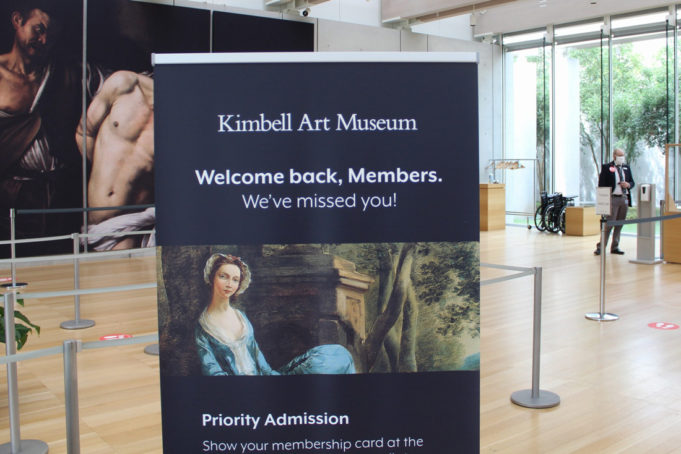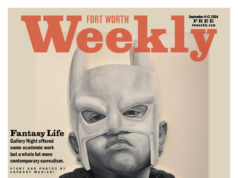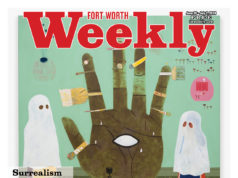Certain experiences cannot be fully appreciated online. All three of the Cultural District’s major museums have recently reopened under stringent sanitation protocols. My first visit on a recent morning was to the Modern Art Museum of Fort Worth, which offers half-price tickets on Sundays and free admission on Fridays. Before I entered, two large signs near the entrance reminded visitors to wear face masks and refrain from entering if exhibiting symptoms of a cold or flu.
The top floor houses Mark Bradford: End Papers (through January 10, 2021), Ruckus Rodeo (through August 16), and FOCUS: Hrair Sarkissian (through November 6). As I stepped into Red Grooms’ Ruckus Rodeo, which was originally slated to coincide with the 2020 Southwestern Exposition and Livestock Show in Fort Worth, I found myself in a phantasmagorical world of sculptures. The cartoonish canvas- and burlap-based works are bright, cartoonish, and a little eerie.
Nearby, I caught Bradford’s popular show. Bradford’s humor was evident in titles like “Jheri Now, Curl Later” and “High Roller Cats Gonna Pay for That.” End papers, as I had to look up, are the thin sheets that protect hair strands during salon treatments. His use of end papers adds a sense of fragility to many of the works. Bradford uses his unique language of squares to convey themes by playing with color, base materials, and inferred outlines that result from the layering of paper sheets.
Two contrasting works caught my attention. “Leucosia” was a lovely blue-hued work that invites the viewer to plumb the depths of black horizontal valleys or skim lighter peaks. The experience of being lost in an abyss of indigo was oddly comforting. Nearby “Los Moscos” had a violent temperament. Fissures jutted outward from four epicenters, like a sheet of ice giving under the forces of oppressive weight and revealing a partially hidden neon background.
The ongoing war and sectarian strife in Syria is brought to life through Sarkissian’s photos and videos. One video-based piece, “Homesick,” powerfully portrays the forces of erasure. “Homesick” consists of two screens: one showing the slow demolition of the artist’s home in Damascus and one featuring the artist hammering at an offscreen object. The two videos are synchronized to tie Sarkissian’s labored blows with the slow but steady destruction of his home.
The museum’s bottom floor features selections from the permanent collection by Pablo Picasso, Andy Warhol, Mark Rothko, and other leading artists of the 20th century. Café Modern, the Modern’s popular restaurant and bar, remains closed indefinitely, as I was told.
As I walked to nearby Kimbell Art Museum, I prepared for a wholly different experience. The Kimbell’s special exhibit, Flesh and Blood, features nearly 40 masterpieces from the Capodimonte Museum in Naples that will remain on display through July. Kimbell staff had carefully cordoned off entrances to ensure social distancing, and, as with the Modern, hand sanitizer abounded. Across the lawn, the Renzo Piano Pavilion affords plenty of space to take in art without having to bump elbows with fellow visitors.
The large oil paintings cover the Renaissance and Baroque eras and largely feature Biblical themes — no surprise given the Catholic Church’s role as a leading commissioner of the arts at the time. Artemisia Gentileschi’s “Judith and Holofernes” was lovely and gory. The setting depicts the Jewish heroine Judith beheading the Assyrian general Holofernes. Judith appears at ease as she severs the general’s head using a golden sword. Pools of blood spill down the bed that Holofernes is being held down against.
Another powerful moment came from the viewing of “Saint Jerome” by Jusepe de Ribera. The scale of the work and the careful placement of the large oil painting lend the viewer a sense of Saint Jerome’s peril. He stood near my eye level as we both gazed upward to a black cloud. Breaking through the darkness, an angel emerged with horn in hand to announce the imminent death of the saint.
The Amon Carter Museum of American Art recently closed The Perilous Texas Adventures of Mark Dion, a show that tied past and present together through the genius of its curatorial layout and the guiding story of New York-based artist Dion. As the show demonstrated, the lines between artists and historians are often blurred, especially in 19th-century Texas, where explorers turned to art to document scenes and artists became inadvertent recorders of history.
The “artist explorer,” one display explained, was critical to the commercial and scientific enterprises of 19th-century Texas. The first room of the show featured historic artist materials like watercolors, rulers, brushes, pigments, and sketchbooks. Dion stepped in as the modern artist explorer in the final gallery room that featured the tools he used to document and record Texas’ vast landscapes.
On view through September 6, you can still see Culture Shock: American Artists from Europe, the show of nearly 40 prints and drawings by European artists who emigrated to the United States in the first half of the 20th century, and “Puente Nuevo,” Justin Favela’s vibrant mural that is made from the same materials used to construct piñatas.
Fort Worth’s fourth museum, the Sid Richardson Museum, remains closed at its Sundance Square location. The National Cowgirl Museum and Hall of Fame opened June 24 under new sanitation guidelines. The Fort Worth Museum of Science and History recently announced that it has delayed its planned mid-July opening date due to the current spike in COVID-19 cases in Tarrant County and Texas. The Fort Worth Community Arts Center has reopened during normal business hours. Five new artist exhibitions will open Friday, July 24, a spokesperson said.












